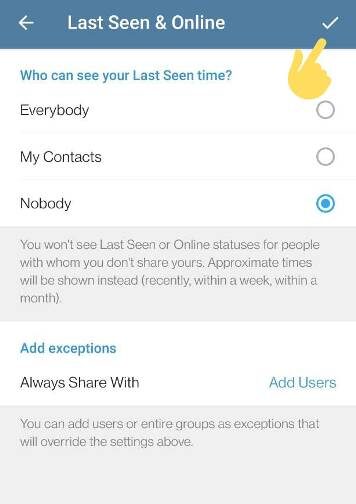Have you ever wondered what the "last seen" feature on Telegram really means? You're not alone! This little tool can spark curiosity or even concern among users. The feature provides insights into when your contacts were last active on the platform, helping you gauge when they might be available to chat. But how accurate is it? And what does it reveal about user privacy? Let’s dive deeper into this intriguing aspect of Telegram.
How the Last Seen Function Works

The "last seen" feature on Telegram is designed to give users visibility into each other’s activity on the platform. In essence, it displays the last time a contact was online, using timestamps like "last seen recently," "last seen within a week," or even specific times like "last seen today at 3:45 PM." However, there’s more to it than just a simple timestamp.
Here’s a breakdown of how it operates:
- Real-time Updates: Whenever a user opens the app, Telegram updates the last seen status in real-time. This means if you’re active, your contacts can see that you are online.
- Privacy Settings: Users have control over their last seen visibility. You can customize your settings to show your last seen status to everyone, only your contacts, or nobody at all.
- Active Status Indicators: If someone is using Telegram actively, you might see them as "online." This can happen even if the user has disabled their last seen timestamp, highlighting the app's complexity in balancing privacy and connectivity.
- Time Frames: The last seen status doesn't merely stop at a timestamp. Instead, Telegram categorizes users into several groups based on their last activity, from "last seen a long time ago" to "last seen recently." This helps provide a more generalized view of a user's activity.
Now, let’s delve deeper into the implications of these features:
| Visibility Setting | Description |
|---|---|
| Everyone | All Telegram users can see your last seen status. |
| Contacts | Only users you have saved as contacts can view your last seen status. |
| Nobody | No one, including your contacts, can see your last seen status. |
It's noteworthy that users who choose to hide their last seen status also won't be able to see others' last seen timestamps. This reciprocal arrangement promotes a sense of fairness, allowing users to opt out of scrutiny while also removing their visibility into others’ activity.
In addition to these privacy features, Telegram's security protocols come into play as well. Your last seen data is encrypted, ensuring that it’s less susceptible to unauthorized access. While this adds a layer of security, it’s essential to remember that if you’re online, that status may be visible to others unless you’ve adjusted your settings accordingly. In a world where privacy is paramount, understanding how this feature operates can help you make informed choices about your online presence.
Also Read This: How to Hide Your Phone Number in Telegram: Exploring Privacy Settings Further
3. Factors Affecting Last Seen Accuracy

Understanding how accurate the Last Seen feature on Telegram really is can be a bit tricky. There are several factors that influence its accuracy, and knowing these can help you navigate the platform more effectively.
Here are some key factors that play a role in the accuracy of the Last Seen feature:
- User Activity: The most straightforward aspect is simply whether a user is actively using the app. If someone hasn’t opened Telegram in a while, their Last Seen time might not be updated, leading to perceived inaccuracies.
- Network Connectivity: Poor internet connection can also impact how quickly the Last Seen status updates. If you're struggling with weak signal strength or intermittent connectivity, you might notice delays in the updates.
- App Version: Keeping your Telegram app updated is crucial. Older versions might have bugs or glitches that affect how Last Seen works. Make sure you're on the latest version to ensure the most accurate notifications.
- Device Settings: Sometimes, your phone's power-saving settings can affect how apps refresh their status. If you're using battery saver mode, it might limit how often Telegram updates your Last Seen.
- Time Zone Differences: Another fascinating aspect is time zone settings. If people have different time zones set up on their devices or in their profile settings, it might cause confusion about when they were last online.
Considering these factors can help users understand the context behind what they see on Telegram regarding Last Seen. Remember that it's not always a straightforward representation of someone's online activity; some underlying factors can lead to discrepancies.
Also Read This: What Are the Benefits of Telegram? Exploring Features and Advantages
4. Privacy Settings and Their Impact

Privacy is a significant concern for many Telegram users, and the Last Seen feature is no exception. How you choose to manage your privacy settings can drastically alter how your Last Seen status is perceived—not just by others but also how accurately it reflects your online presence.
Here are some insights on how different privacy settings can impact the Last Seen feature:
- Who Can See Your Last Seen: In Telegram, you have control over who can view your Last Seen information. You can set it to “Everyone,” “My Contacts,” or “Nobody.” The choice you make impacts not only your privacy but also how others can interpret your activity. For instance, if you set it to "My Contacts," only people you’ve saved can see when you were last online.
- Who Can See Your Profile Picture: Interestingly, the visibility of your profile picture is tied to privacy settings as well. If users can’t see your profile picture, they may also find it harder to trust that your Last Seen status is accurate, leading to speculation.
- Shared Contacts: When you add users from your phone’s contact list to Telegram, they may gain access to view your Last Seen status if you have permitted it. Depending on the level of trust you have with these contacts, you might want to adjust your settings accordingly.
- Blocked Users: If you block someone on Telegram, they won’t see your Last Seen status at all. This adds another layer to how people perceive your online activity. They may not realize you've blocked them and could misinterpret your absence as unfriendliness.
- Custom Settings: Telegram allows for exciting customization. You can create exceptions in your settings, allowing certain contacts to see your Last Seen while blocking others. This fine-tuning benefits users who want to maintain a layer of privacy while still being accessible to select individuals.
Your privacy settings can significantly shape your experience on Telegram, especially concerning how Last Seen is interpreted. Being intentional about these settings not only enhances your experience but also helps maintain better relationships with your contacts.
Also Read This: How to Check Your Telegram Account Settings and Privacy
5. User Experiences and Feedback
When it comes to the Last Seen feature on Telegram, user experiences tend to vary widely. Many people appreciate the ability to see when their contacts were last active, claiming it enhances communication by providing more context to the conversations. For example, if you know someone was online just a few minutes ago, it can make your follow-up message feel more timely and relevant.
However, not all experiences are positive. Some users express privacy concerns, feeling uncomfortable with broadcasting their online status. In a world where online privacy is becoming increasingly important, this feature can feel intrusive. For those individuals, the option to hide their Last Seen status becomes crucial. It's worth noting that user reactions highlight the duality of the feature: it can be a helpful tool for convenience, but it also raises questions about privacy.
Feedback from Telegram forums and social media shows a mixed bag of opinions:
- Convenience: Many users enjoy knowing when their friends were last active, facilitating better timing for conversations.
- Privacy Concerns: Some users feel uneasy about others knowing their online habits, leading them to adjust their privacy settings.
- False Expectations: There are instances where a user misinterprets the Last Seen status, leading to unnecessary misunderstandings.
- Dependency: Several users admitted to becoming overly reliant on this feature, affecting how they manage their social interactions.
This mixed feedback raises an important question: is there a way to strike a balance between the convenience of having Last Seen information and maintaining a sense of privacy? Many users have taken to utilizing the privacy settings Telegram offers, customizing their experience to align with their needs.
Ultimately, user experiences reflect a broader debate about privacy versus connectivity in the digital age. It’s clear that while many celebrate the utility of the Last Seen feature, others are conscious of its implications on personal privacy.
Also Read This: How to Unblock Someone on Telegram
6. Alternatives to the Last Seen Feature
If you find the Last Seen feature on Telegram too intrusive or simply want to explore different ways to communicate without the pressure of online status, there are several alternatives to consider. These options can help foster conversations while maintaining a sense of privacy.
Here are some methods you can use:
- Direct Messaging: Instead of relying on Last Seen information, consider sending a message directly. This way, you can engage the person without needing to check their online status first. If they respond, great! If not, you can leave it at that and respect their space.
- Scheduled Messages: Many messaging apps offer the option to schedule messages. This can be a fantastic way to keep in touch at the right time without worrying about whether the other person is online.
- Voice or Video Calls: Sometimes, a quick voice or video call can eliminate the uncertainty of messaging. If you need to connect urgently, a call can be more effective than sending a text and waiting for a response.
- Group Chats: Instead of one-on-one conversations, think about creating a group chat. This way, you can communicate with multiple people at once, making it less about individual Last Seen statuses and more about collective interaction.
- Use Other Platforms: If privacy is a significant concern, you might want to explore other messaging platforms that prioritize user privacy. Apps like Signal and Wickr offer robust privacy features that can help maintain your anonymity while ensuring effective communication.
By embracing these alternatives, users can engage in meaningful conversations without being tied down by the implications of the Last Seen feature. Whether it’s through direct communication methods or exploring other platforms, there’s always a way to keep the conversation flowing while safeguarding your privacy!
Conclusion: Key Takeaways on Last Seen Accuracy
In summary, the accuracy of the Telegram Last Seen feature is influenced by various factors that users should consider:
- Privacy Settings: Users can control who sees their last seen status through privacy settings, affecting visibility.
- Internet Connectivity: A user's online status may not update accurately due to poor or intermittent internet connections.
- Device Syncing: Multiple devices logged into the same account may showcase different last seen information.
- Time Zones: Differences in time zones can impact the perceived timing of last seen updates.
- Application Updates: Regular updates to the Telegram app may introduce bugs or changes in how last seen is displayed.
It is essential to understand that while the feature provides a general sense of when contacts were last active, it is not infallible. Users should be aware of the limitations and potential inaccuracies associated with the last seen functionality. Always prioritize appropriate privacy settings to maintain control over your own visibility.
Ultimately, while the Last Seen feature offers insights into user activity, it is not a definitive source, making user discretion and understanding key to navigating conversations and expectations on the platform.
 admin
admin








